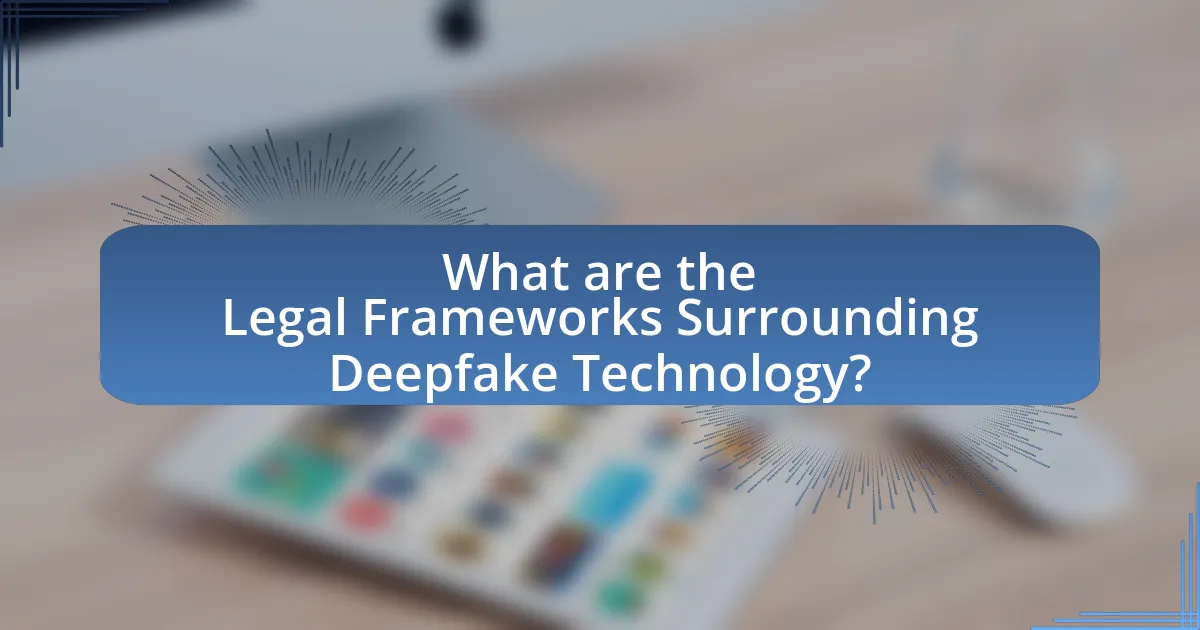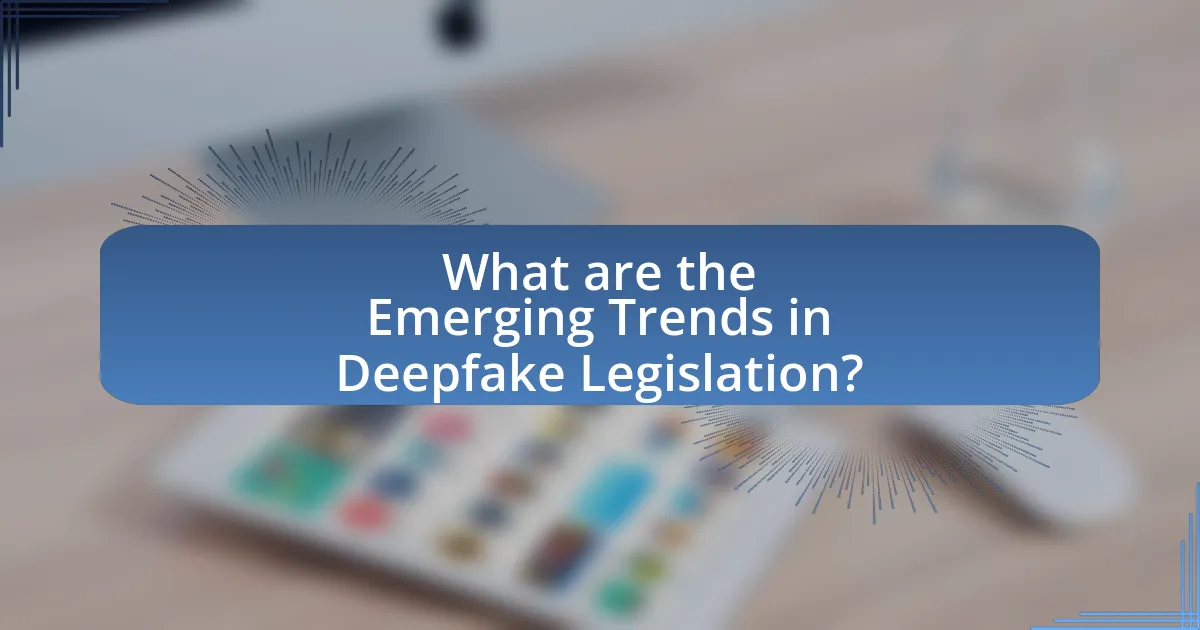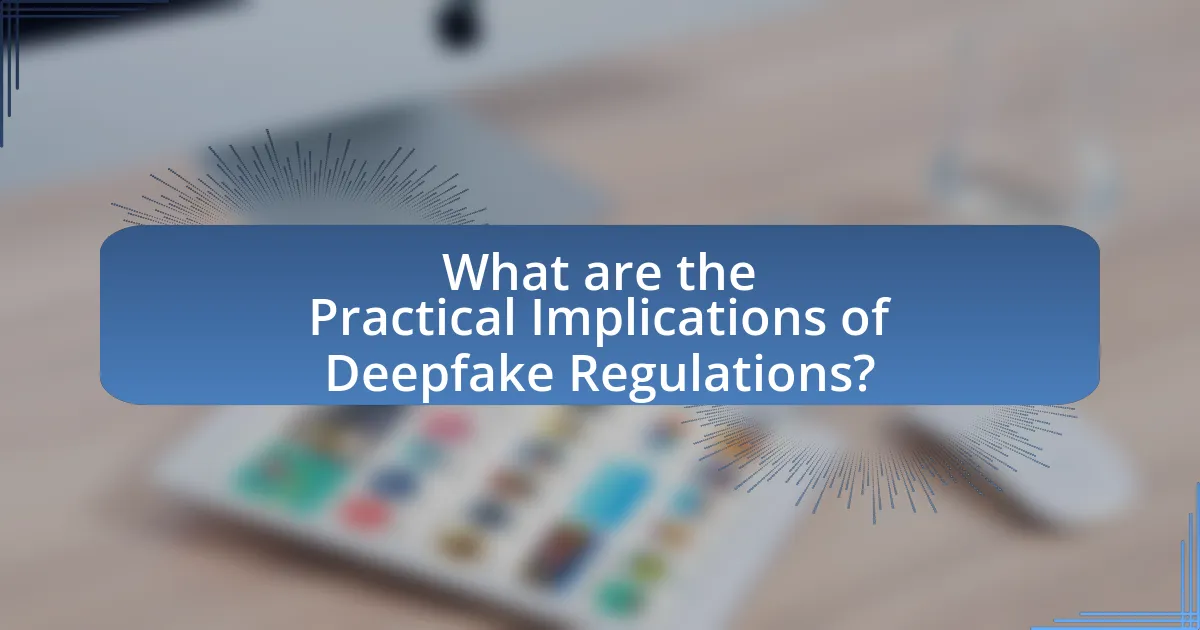The article examines the legal frameworks surrounding deepfake technology, highlighting existing laws related to intellectual property, privacy, and defamation, as well as emerging legislation specifically targeting deepfakes. It discusses how current laws address challenges posed by deepfakes, including defamation, copyright infringement, and privacy violations, while also exploring the variations in regulations across different jurisdictions. The article further analyzes the role of intellectual property laws, ethical considerations in regulation, and the responsibilities of creators and distributors of deepfakes. Additionally, it outlines emerging trends in legislation, government responses, and the implications of deepfake regulations for individuals and organizations.

What are the Legal Frameworks Surrounding Deepfake Technology?
The legal frameworks surrounding deepfake technology primarily consist of existing laws related to intellectual property, privacy, and defamation, as well as emerging legislation specifically targeting deepfakes. Current laws, such as the Digital Millennium Copyright Act, address copyright infringement, while privacy laws protect individuals from unauthorized use of their likeness. Additionally, several states in the U.S. have enacted laws that criminalize the malicious use of deepfakes, particularly in contexts like revenge porn or election interference. For instance, California’s AB 730 makes it illegal to use deepfakes to harm or defraud others. These frameworks are evolving to address the unique challenges posed by deepfake technology, reflecting the need for legal adaptation in response to technological advancements.
How do current laws address the challenges posed by deepfake technology?
Current laws address the challenges posed by deepfake technology primarily through existing statutes related to fraud, defamation, and intellectual property. For instance, many jurisdictions apply laws against identity theft and fraud to combat malicious uses of deepfakes, as these technologies can create misleading representations that harm individuals or organizations. Additionally, some states have enacted specific legislation targeting deepfakes, such as California’s law that prohibits the use of deepfakes to harm or defraud others, particularly in the context of elections and pornography. These legal frameworks aim to deter the misuse of deepfake technology by imposing penalties and providing victims with avenues for recourse.
What specific legal issues arise from the use of deepfakes?
The specific legal issues arising from the use of deepfakes include defamation, copyright infringement, and violations of privacy rights. Defamation occurs when deepfakes are used to create false representations that harm an individual’s reputation, leading to potential lawsuits. Copyright infringement can arise when deepfakes utilize copyrighted material without permission, violating intellectual property laws. Additionally, deepfakes can infringe on privacy rights by misappropriating an individual’s likeness or voice without consent, which can lead to legal action under various privacy statutes. These issues highlight the need for updated legal frameworks to address the unique challenges posed by deepfake technology.
How do existing regulations vary across different jurisdictions?
Existing regulations regarding deepfake technology vary significantly across different jurisdictions, reflecting diverse legal frameworks and cultural attitudes towards privacy, misinformation, and digital content. For instance, the United States lacks a comprehensive federal law specifically addressing deepfakes, leading to a patchwork of state laws that focus on issues like fraud, harassment, and copyright infringement. In contrast, the European Union has proposed regulations under the Digital Services Act that aim to tackle harmful content, including deepfakes, with stricter accountability measures for platforms. Additionally, countries like China have implemented specific laws that regulate the creation and distribution of deepfake content, emphasizing the protection of national security and public order. These variations illustrate how legal responses to deepfake technology are shaped by local priorities and societal values.
What role do intellectual property laws play in deepfake technology?
Intellectual property laws play a crucial role in regulating deepfake technology by addressing issues of copyright, trademark, and privacy rights. These laws help determine the ownership of the content used to create deepfakes, as unauthorized use of copyrighted material can lead to legal repercussions. For instance, if a deepfake utilizes an actor’s likeness without permission, it may infringe on their rights under copyright law, which protects original works of authorship. Additionally, trademark laws can be invoked if a deepfake misuses a brand’s image or reputation, potentially leading to consumer confusion. Furthermore, privacy laws protect individuals from having their likenesses manipulated without consent, reinforcing the legal boundaries around the creation and distribution of deepfakes.
How can copyright laws be applied to deepfake content?
Copyright laws can be applied to deepfake content by recognizing that the creation of deepfakes often involves the unauthorized use of copyrighted materials, such as images, videos, or audio of individuals. When a deepfake utilizes these elements without permission, it can infringe on the copyright holder’s rights, leading to potential legal action. For instance, if a deepfake video uses a celebrity’s likeness without consent, the celebrity may pursue a copyright claim based on the unauthorized reproduction and distribution of their image. Additionally, the Digital Millennium Copyright Act (DMCA) provides a framework for addressing copyright infringement online, allowing copyright owners to request the removal of infringing content. This legal context underscores the importance of copyright laws in regulating deepfake technology and protecting the rights of content creators.
What are the implications of trademark laws on deepfake usage?
Trademark laws significantly impact deepfake usage by protecting brand identities and preventing consumer confusion. When deepfakes utilize trademarks without authorization, they can infringe on the rights of trademark owners, leading to potential legal actions. For instance, if a deepfake video misuses a brand’s logo or name, it may mislead viewers into believing the brand endorses the content, which violates the Lanham Act in the United States. This act prohibits false advertising and trademark infringement, thereby holding creators of deepfakes accountable for unauthorized use of trademarks.
What ethical considerations are involved in regulating deepfakes?
Regulating deepfakes involves several ethical considerations, primarily centered around misinformation, consent, and potential harm. Misinformation arises when deepfakes are used to create misleading content that can damage reputations or influence public opinion, as evidenced by instances where manipulated videos have swayed electoral outcomes. Consent is crucial, as individuals depicted in deepfakes may not have agreed to their likeness being used, raising issues of personal autonomy and privacy. Additionally, the potential for harm is significant; deepfakes can facilitate harassment, defamation, or even incite violence, highlighting the need for a regulatory framework that balances innovation with ethical responsibility. These considerations necessitate careful deliberation to ensure that regulations protect individuals and society while fostering technological advancement.
How do ethical concerns influence public perception of deepfake technology?
Ethical concerns significantly shape public perception of deepfake technology by fostering distrust and fear regarding its potential misuse. The prevalence of deepfakes in disinformation campaigns, particularly during elections, has heightened anxiety about their impact on democracy and personal privacy. A study by the Pew Research Center found that 49% of Americans believe deepfake technology poses a significant threat to society, illustrating widespread apprehension. This perception is further influenced by high-profile cases of deepfake abuse, such as non-consensual pornography, which amplify ethical dilemmas surrounding consent and authenticity. Consequently, these ethical concerns lead to calls for stricter regulations and legal frameworks to mitigate risks associated with deepfake technology.
What responsibilities do creators and distributors of deepfakes have?
Creators and distributors of deepfakes have the responsibility to ensure that their content does not infringe on the rights of individuals, mislead the public, or cause harm. This includes obtaining consent from individuals whose likenesses are used, as well as adhering to laws regarding defamation, privacy, and intellectual property. For instance, in the United States, the use of someone’s image without permission can lead to legal consequences under various state laws, including invasion of privacy claims. Additionally, creators and distributors must be aware of the potential for deepfakes to spread misinformation, which can have serious societal implications, as highlighted by studies showing that deepfakes can influence public opinion and elections.

What are the Emerging Trends in Deepfake Legislation?
Emerging trends in deepfake legislation include the introduction of specific laws targeting the creation and distribution of deepfake content, as well as increased collaboration between governments and technology companies to combat misuse. For instance, several U.S. states, such as California and Texas, have enacted laws that criminalize the malicious use of deepfakes, particularly in contexts like election interference and non-consensual pornography. Additionally, the European Union is working on the Digital Services Act, which aims to hold platforms accountable for harmful content, including deepfakes. These legislative efforts reflect a growing recognition of the potential dangers posed by deepfake technology and the need for regulatory frameworks to address them effectively.
How are governments responding to the rise of deepfake technology?
Governments are implementing regulations and legislation to address the challenges posed by deepfake technology. For instance, the United States has introduced laws in several states, such as California and Texas, that criminalize the malicious use of deepfakes, particularly in contexts like election interference and non-consensual pornography. Additionally, the European Union is working on the Digital Services Act, which aims to hold platforms accountable for harmful content, including deepfakes. These measures reflect a growing recognition of the potential risks associated with deepfake technology, including misinformation and privacy violations.
What new laws or regulations are being proposed globally?
New laws and regulations addressing deepfake technology are being proposed globally to combat misinformation and protect individuals’ rights. For instance, the European Union is advancing the Digital Services Act, which aims to hold platforms accountable for harmful content, including deepfakes. In the United States, several states have introduced bills that criminalize the malicious use of deepfakes, particularly in contexts like election interference and non-consensual pornography. Additionally, Australia is considering amendments to its criminal code to include specific provisions against the creation and distribution of deepfakes. These proposals reflect a growing recognition of the need for legal frameworks to address the challenges posed by deepfake technology.
How are law enforcement agencies adapting to deepfake-related crimes?
Law enforcement agencies are adapting to deepfake-related crimes by developing specialized training programs and utilizing advanced detection technologies. Agencies are collaborating with tech companies and academic institutions to enhance their capabilities in identifying and investigating deepfakes. For instance, the FBI has established a task force focused on digital forensics that includes deepfake analysis, while the Department of Justice has issued guidelines for prosecuting cases involving manipulated media. These adaptations are crucial as deepfake technology becomes increasingly sophisticated, with reports indicating that over 90% of deepfake content is used for malicious purposes, highlighting the urgent need for effective law enforcement responses.
What role do technology companies play in shaping deepfake regulations?
Technology companies play a crucial role in shaping deepfake regulations by influencing policy development through their technological expertise and lobbying efforts. These companies, such as Google and Facebook, actively participate in discussions with lawmakers to establish guidelines that address the ethical and legal implications of deepfake technology. For instance, in 2020, Facebook announced its commitment to combating misinformation, including deepfakes, by collaborating with fact-checkers and developing detection tools. This proactive approach demonstrates how technology firms can drive regulatory frameworks that balance innovation with public safety.
How are tech companies collaborating with lawmakers on this issue?
Tech companies are collaborating with lawmakers on the issue of deepfake technology by engaging in discussions to shape regulatory frameworks that address the ethical and legal implications of this technology. For instance, companies like Facebook and Microsoft have participated in public forums and working groups to provide insights on the potential risks and benefits of deepfakes, while also advocating for balanced regulations that protect users without stifling innovation. This collaboration is evidenced by initiatives such as the Deepfake Detection Challenge, which was supported by tech firms to promote the development of tools that can identify manipulated media, demonstrating a proactive approach to addressing the challenges posed by deepfake technology.
What self-regulatory measures are being adopted by the industry?
The industry is adopting various self-regulatory measures to address the challenges posed by deepfake technology. These measures include the establishment of ethical guidelines for the creation and distribution of deepfake content, the implementation of watermarking technologies to identify manipulated media, and the development of industry standards for transparency in the use of deepfakes. For instance, organizations like the Partnership on AI have created frameworks that encourage responsible use and disclosure of deepfake technologies, aiming to mitigate misinformation and protect individuals’ rights.
What are the potential future developments in deepfake legislation?
Potential future developments in deepfake legislation include the introduction of comprehensive federal laws that specifically address the creation and distribution of deepfake content, as well as enhanced penalties for malicious use. Recent trends indicate that lawmakers are increasingly recognizing the risks associated with deepfakes, leading to proposals for regulations that could require platforms to implement detection technologies and disclose the use of synthetic media. For instance, California’s AB 730, enacted in 2019, serves as a model by criminalizing the use of deepfakes for harassment or fraud, suggesting a shift towards more stringent legal frameworks. Additionally, international cooperation may emerge to standardize regulations across borders, reflecting the global nature of digital content and the need for cohesive legal responses.
How might international cooperation influence deepfake regulations?
International cooperation can significantly enhance deepfake regulations by fostering a unified approach to legal standards and enforcement mechanisms. Collaborative efforts among countries can lead to the establishment of comprehensive frameworks that address the cross-border nature of deepfake technology, ensuring that regulations are consistent and effective globally. For instance, initiatives like the Global Partnership on Artificial Intelligence (GPAI) aim to promote responsible AI use, which includes addressing the challenges posed by deepfakes. By sharing best practices, resources, and technological advancements, nations can create a cohesive strategy that mitigates the risks associated with deepfake misuse, such as misinformation and privacy violations.
What trends in public opinion could affect future legal frameworks?
Trends in public opinion that could affect future legal frameworks include increasing concern over privacy violations and misinformation associated with deepfake technology. As awareness of the potential harms of deepfakes grows, public sentiment is shifting towards advocating for stricter regulations to protect individuals from identity theft and reputational damage. For instance, a 2021 survey by the Pew Research Center found that 70% of Americans believe that deepfakes pose a significant threat to society, indicating a strong demand for legal measures to address these issues. This heightened concern is likely to influence lawmakers to develop comprehensive legal frameworks that address the ethical and legal implications of deepfake technology.

What are the Practical Implications of Deepfake Regulations?
Deepfake regulations have significant practical implications, primarily aimed at mitigating the risks associated with misinformation and privacy violations. These regulations can lead to enhanced accountability for creators and distributors of deepfake content, as legal frameworks may impose penalties for malicious use, thereby deterring harmful practices. For instance, California’s AB 730 law criminalizes the use of deepfakes to harm or defraud individuals, illustrating a legislative approach to protect citizens from deceptive media. Additionally, regulations can foster the development of detection technologies, as companies and researchers may invest in tools to identify deepfakes, thereby improving public trust in digital content. Overall, the establishment of deepfake regulations is crucial for safeguarding individual rights and promoting ethical standards in digital media.
How can individuals and organizations protect themselves from deepfake misuse?
Individuals and organizations can protect themselves from deepfake misuse by implementing advanced detection technologies and promoting digital literacy. Advanced detection technologies, such as AI-based tools, can analyze video and audio content for inconsistencies that indicate manipulation. For instance, companies like Sensity and Deeptrace offer solutions that identify deepfakes with high accuracy, helping organizations verify the authenticity of media before sharing. Additionally, promoting digital literacy among employees and the public can empower individuals to recognize potential deepfake content, reducing the risk of misinformation. Research indicates that awareness and education significantly enhance the ability to discern manipulated media, thereby fostering a more informed community.
What strategies can be employed to verify the authenticity of media?
To verify the authenticity of media, individuals can employ strategies such as reverse image searches, metadata analysis, and fact-checking through reputable sources. Reverse image searches, using tools like Google Images or TinEye, allow users to trace the origin of an image and identify alterations. Metadata analysis involves examining the file information for details like creation date and editing history, which can reveal inconsistencies. Fact-checking through established organizations, such as Snopes or FactCheck.org, provides context and verification against known falsehoods. These methods are supported by studies indicating that misinformation can be effectively countered through diligent verification practices.
How can legal recourse be pursued in cases of deepfake exploitation?
Legal recourse in cases of deepfake exploitation can be pursued through various legal avenues, including defamation claims, invasion of privacy lawsuits, and violations of intellectual property rights. Victims can file lawsuits based on the harmful effects of deepfakes, such as reputational damage or emotional distress, which are actionable under defamation laws. Additionally, if a deepfake involves the unauthorized use of someone’s likeness, it may constitute an invasion of privacy, allowing the victim to seek damages. Furthermore, if the deepfake infringes on copyright or trademark rights, the victim can pursue claims under intellectual property law. Legal frameworks are evolving to address these issues, with some jurisdictions considering specific legislation targeting deepfake technology, thereby providing clearer pathways for victims to seek justice.
What best practices should be followed in the creation and distribution of deepfakes?
Best practices in the creation and distribution of deepfakes include ensuring transparency, obtaining consent, and adhering to ethical guidelines. Transparency involves clearly labeling deepfake content to inform viewers that it has been altered, which helps mitigate misinformation. Obtaining consent from individuals whose likenesses are used is crucial to respect privacy rights and avoid legal repercussions. Adhering to ethical guidelines, such as avoiding harmful or malicious uses of deepfakes, is essential to prevent potential abuse and maintain public trust. These practices align with emerging legal frameworks aimed at regulating deepfake technology and protecting individuals from misuse.
How can ethical guidelines be established for deepfake creators?
Ethical guidelines for deepfake creators can be established through a collaborative framework involving stakeholders such as technology developers, legal experts, ethicists, and policymakers. This collaboration can lead to the creation of standards that prioritize transparency, consent, and accountability in deepfake production. For instance, the establishment of clear consent protocols for individuals whose likenesses are used can mitigate potential harm and misuse. Additionally, organizations like the Partnership on AI have proposed ethical principles that emphasize the importance of responsible AI use, which can serve as a foundation for deepfake guidelines. By integrating these principles into legal frameworks, society can better navigate the ethical implications of deepfake technology.
What role does transparency play in responsible deepfake usage?
Transparency is crucial in responsible deepfake usage as it fosters trust and accountability among creators and consumers. By clearly disclosing the synthetic nature of deepfake content, users can make informed decisions about its authenticity and intent. Research indicates that transparency can mitigate the potential for misinformation and manipulation, as seen in studies where audiences were better able to discern deepfake videos when informed about their artificiality. This approach aligns with ethical guidelines and legal frameworks that aim to regulate deepfake technology, ensuring that its applications are used responsibly and do not infringe on individual rights or societal norms.
What resources are available for staying informed about deepfake legislation?
To stay informed about deepfake legislation, individuals can utilize resources such as government websites, legal journals, and technology policy organizations. Government websites, like the Federal Trade Commission and state legislative sites, provide updates on proposed and enacted laws. Legal journals, such as the Harvard Law Review and the Yale Law Journal, often publish articles analyzing deepfake legislation and its implications. Additionally, organizations like the Electronic Frontier Foundation and the Center for Democracy & Technology offer insights and reports on the evolving legal landscape surrounding deepfake technology. These resources collectively ensure access to accurate and timely information regarding deepfake legislation.
How can stakeholders engage with ongoing discussions about deepfake laws?
Stakeholders can engage with ongoing discussions about deepfake laws by participating in public forums, contributing to policy drafts, and collaborating with advocacy groups. Public forums, such as town hall meetings or online webinars, provide platforms for stakeholders to voice their opinions and concerns directly to lawmakers. Contributing to policy drafts allows stakeholders to influence the legislative process by providing expert insights and recommendations. Collaborating with advocacy groups, which often have established networks and resources, can amplify stakeholders’ voices and ensure that diverse perspectives are considered in the development of deepfake regulations. These methods facilitate active participation in shaping the legal frameworks surrounding deepfake technology.
What organizations provide updates on legal developments in this area?
Organizations that provide updates on legal developments surrounding deepfake technology include the Electronic Frontier Foundation (EFF), the American Bar Association (ABA), and the International Association of Privacy Professionals (IAPP). The EFF focuses on civil liberties in the digital world and regularly publishes insights on technology-related legal issues. The ABA offers resources and updates on various legal topics, including emerging technologies like deepfakes. The IAPP provides information on privacy laws and regulations, which are increasingly relevant as deepfake technology evolves. These organizations are recognized for their contributions to legal discourse and advocacy in the context of technology and privacy.

